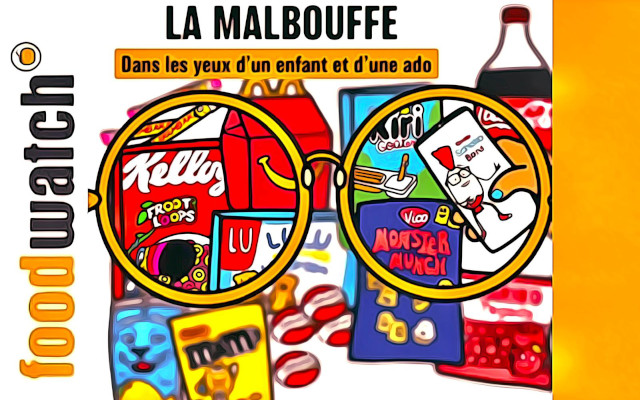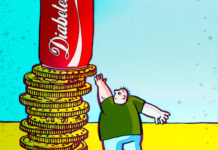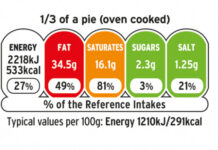Helping consumers identify junk-food – in France and in the EU, by using the Nutri-Score nutritional labelling system – and ban its advertising, as already decided in the UK. This is the strategy called for by a committee of French health professionals, and civil society, to combat the youth obesity epidemic.
1) UK, marketing restrictions. The British example
In recent years, the UK has shown attention to health policies aimed at combating obesity, overweight and related diseases (cardiovascular, metabolic, oncological, diabetes, etc.). Starting with the introduction of the ‘soda tax’ which, as we have seen, has reduced the average weekly intake of sugar by 30 g per capita. (1)
‘More than one in five children in England is obese or overweight when they start primary school and this figure rises to more than a third when they leave it, NHS Digital statistics show. 63% of adults in the UK in turn are above a healthy weight and, of these, half are living with obesity,’ explains the UK government’s health department. (2)
The solution to such a serious situation (particularly in ethical minorities and less affluent socio-economic backgrounds) requires targeted interventions. Among them, inevitably, the restriction of advertising of HFSS (High in Fat, Sugar and Salt) foods:
– on TV, including pay-TV platforms, before 9 p.m
– online, all the time.
Products identification subject to advertising restrictions will be formalised in the coming months.
1.1) UK, restrictions at the start after two postponements
The restrictive measures will come into force, better late than never, on 1 October 2025. So at least the new Labour-led British government promises. In fact, pressure from the junk food lobby has twice succeeded in getting the marketing restrictions on junk food postponed.
‘The previous conservative government had pledged to introduce the ban from January 2023. But a month before its introduction, Rishi Sunak (the premier, ed) decided to postpone it to 2025, triggering a wave of criticism for putting the interests of big business before improving children’s health.
Boris Johnson, one of Sunak’s predecessors, had planned to implement the same measure. But he too postponed it, ostensibly to help families cope with the cost of living crisis’, reconstructs The Guardian. (3)
2) France, the appeal of the health workers
Obesity also threatens French citizens, like those of the entire Old Continent (WHO Europe, 2022). Its incidence in France has doubled in 23 years – from 8.5% in 1997 to 17% in 2020 – and could continue to grow to affect between a quarter and a third of adults by 2030.
The problem is certainly not aesthetic. Obesity in fact:
– has serious complications, increases the risk of developing type 2 diabetes, cardiovascular diseases, cancers, psychological disorders, with a significant worsening of the quality of life, also due to stigma and discrimination;
– risks becoming an unsustainable cost for the state coffers. In 2020, the French health system (insurance-type) devoted €8.4 billion to obesity-related treatments, or almost 4% of its total expenditure.
Health expenditure, at this rate, could exceed 13 billion/year by 2030. Not to mention the social (also economic) impact in terms of premature deaths and sickness absence from work.
2.1) The two-pronged strategy
The basic premise is that bad eating habits, marked by the over-consumption of too-fat, too-salty, too-sweet and ultra-processed foods, are not just the responsibility of individuals, as the junk food lobbies claim. (4)
The issue is broader since it concerns the accessibility of healthy food and the manipulation of young people, especially the socially disadvantaged, through predatory marketing strategies (Unicef, 2020), with devious and hammering advertisements.
The tool to be activated is therefore modulated in two simultaneous actions:
– make it compulsory to label the Nutri-Score, the famous indicator of the nutritional quality of foodstuffs in five levels (from the best A to the worst E), which has been extensively discussed; (5)
– ban all forms of advertising for all foods with a NutriScore D or E and ultra-processed foods (rich in additives and synthetic flavourings, as well as nutritionally unbalanced).
2.2) The Trashiness of Junk-Food Commercials
The pressure of junk-food marketing on French citizens is well expressed in the analysis conducted by the committee of health professionals on the content of TV commercials during joint adult/child viewing hours in 2022:
– 57% of the commercials promoted on Nutri-Score D and E rated foods;
– only 1% of the commercials concerned fruit and vegetables. (6)
The correlation between these advertising messages and the adoption of health-damaging behaviour is well known and confirmed in the scientific literature. Any further hesitation in health policies, which should also include fiscal measures (WHO, 2024), is therefore unjustified, as Foodwatch France pointed out as early as 2023. (7)
Marta Strinati
Footnotes
(1) Marta Strinati. WHO chooses the UK model to reduce calories and sugar in the Old Continent. GIFT (Great Italian Food Trade).
(2) Introducing further advertising restrictions on TV and online for products high in fat, salt or sugar: government response to consultation on secondary legislation. gov.uk.12.9.24 https://tinyurl.com/2jphhydu
(3) Denis Campbell. Junk food TV ads to be banned pre-watershed in UK from October 2025. The Guardian 12.9.24 https://tinyurl.com/wszf3phr
(4) Marta Strinati, Dario Dongo. Soda tax, here’s how Big Food counteracts health policies. And how to react. GIFT (Great Italian Food Trade).
(5) Dario Dongo. Andrea Adelmo Della Penna. Italian scientific study confirms the effectiveness of NutriScore. GIFT (Great Italian Food Trade).
(6) Tribune collective. Obésité: inspirations-nous du Royaume-Uni et adoptons une loi Evin contre la malbouffe. Tribune. the Express. 30.9.24 https://tinyurl.com/mkh999ef
(7) Les enfants, cibles du marketing de la malbouffe : l’heure de l’action politique. Foodwatch. 13.9.23 https://www.foodwatch.org/fr/actualites/2023/les-enfants-cibles-du-marketing-de-la-malbouffe-l-heure-de-l-action-politique/
Professional journalist since January 1995, he has worked for newspapers (Il Messaggero, Paese Sera, La Stampa) and periodicals (NumeroUno, Il Salvagente). She is the author of journalistic surveys on food, she has published the book "Reading labels to know what we eat".








